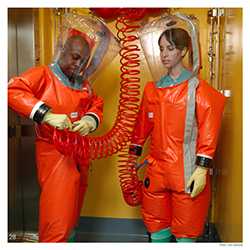NCEZID: Protecting Americans From Bioterrorism
At NCEZID, our first priority is to keep people safe. Preparing for infectious disease threats—naturally occurring or intentional—is one of the mission-critical activities of NCEZID. We do not know when—or if—a national health emergency like the anthrax attacks of 2001 might happen again. What we do know is that if anthrax or another biological agent were intentionally released, NCEZID will be central to CDC’s response because of three primary and unique assets:
- We have the scientific expertise. At CDC, the scientists who specialize in the scariest pathogens work at NCEZID. NCEZID’s epidemiologists and microbiologists are among the world’s leading experts in highly pathogenic bacteria and viruses like those that cause anthrax, botulism, plague, smallpox, and Ebola.
They also handle less-familiar but dangerous germs that cause brucellosis, tularemia, Q fever, Lassa fever, Rift Valley fever, and other viral hemorrhagic fevers.These specialized NCEZID scientists are vital in helping CDC and its partners prepare by developing diagnostic tests and updated guidance for clinicians, laboratories, public health officials, and the public. All of this would be critically important to saving lives during a large-scale public health emergency caused by bioterrorists. - We oversee work in CDC’s high-containment labs (HCL). Many of the dangerous pathogens that could cause major outbreaks or be used in bioterrorism are securely handled in HCL labs. The biosafety level (BSL)-3 lab handles pathogens that could cause serious illness, but could be treated. Pathogens that are even more deadly and for which no vaccine or treatment is available require containment in the most secure facility, the BSL-4 lab.
- We manage the Laboratory Response Network (LRN). The LRN is a unique network of more than 130 laboratories established in collaboration with the Federal Bureau of Investigation and the Association of Public Health Laboratories to respond to bioterrorism, chemical terrorism, and other public health emergencies. The network includes state and local public health laboratories, as well as veterinary, agriculture, military, law enforcement, and water- and food-testing labs. When an emergency strikes, the LRN quickly mobilizes as it did during the anthrax investigation of 2001 and in 2014 for the Ebola outbreak.
Bioterrorism has the potential to quickly kill millions of people.
- Page last reviewed: August 25, 2017
- Page last updated: August 25, 2017
- Content source:
Centers for Disease Control and Prevention
National Center for Emerging and Zoonotic Infectious Diseases (NCEZID)


 ShareCompartir
ShareCompartir
